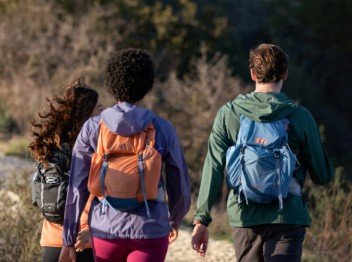
In the competitive realm of outdoor equipment, the design and quality of hiking backpacks are crucial, but it’s the underlying sourcing strategy that truly defines a brand’s success. Efficient sourcing ensures consistent product quality, cost-effective production, and rapid adaptability to ever-changing market trends. Furthermore, it allows brands to prioritize sustainability, meet modern consumer demands, and foster innovation through supplier collaborations. In essence, while a backpack’s design might attract consumers, it’s the strategic sourcing that solidifies a brand’s standing in the market.
1. Historical Perspective
A. Traditional backpack designs and materials
In the earliest days of outdoor exploration, hiking backpacks were relatively simple, often crafted from durable materials like canvas, leather, and later, nylon. These materials were chosen primarily for their ruggedness and ability to withstand the elements. The designs were straightforward, with a primary compartment for essentials and perhaps a few external pockets. The focus was primarily on durability and utility rather than comfort or aesthetics.
B. Evolution of hiking backpack features over the decades
As outdoor recreation grew in popularity throughout the 20th century, so did the demand for more specialized and comfortable backpacks. The 1960s and 70s saw the introduction of lightweight aluminum frames, which distributed weight more evenly and offered improved comfort. In subsequent decades, innovations like padded shoulder straps, hip belts, and ventilation systems became standard. Advances in material science also introduced fabrics that were lighter, more durable, and water-resistant. Additionally, the rise of specialized hiking activities, such as mountaineering or ultralight backpacking, spurred the creation of purpose-designed packs to cater to specific needs.
C. Transition from function to function + fashion
The turn of the 21st century marked a significant shift in hiking backpack design. While function remained crucial, aesthetics began to play an increasingly important role. Backpacks started to sport sleeker designs, vibrant colors, and patterns. This transition can be attributed to the urbanization of outdoor gear, where items were not just used in the wilderness but also in daily urban life. Brands began to recognize the value of creating packs that were both functional on the trail and stylish in the city. Thus, the modern hiking backpack has become a blend of performance, comfort, and fashion, reflecting the diverse demands of today’s outdoor enthusiasts.

2. Current Trends
A. Lightweight and minimalist designs
Modern hiking enthusiasts prioritize efficiency and mobility, leading to the rise of lightweight and minimalist backpack designs. By shedding unnecessary weight and focusing only on essential features, these packs allow hikers to move faster and reduce fatigue. Materials like ripstop nylon and ultralight mesh have become popular for their durability-to-weight ratio. Brands are constantly innovating to strike a balance between providing necessary features and minimizing pack weight.
B. Integration of technology: e.g., solar chargers, hydration systems
Technology’s integration into hiking backpacks showcases how modern design meets the digital age’s demands. Solar chargers, often built into the pack’s exterior, allow hikers to harness solar energy to charge devices, ensuring they remain connected even in remote locations. Hydration systems, consisting of a water bladder and an easily accessible drinking hose, have become almost standard, enabling hikers to drink without needing to stop and rummage for a water bottle. Some packs even come with built-in LED lights for nighttime navigation or USB ports powered by kinetic energy.
C. Sustainable and eco-friendly materials
With growing awareness of environmental concerns, there’s a strong push towards sustainability in outdoor gear. Brands are exploring materials like recycled plastics, organic cotton, and sustainably sourced natural fibers to craft their backpacks. This shift isn’t just about using eco-friendly materials but also about adopting production processes that have a reduced carbon footprint, ensuring that the product’s entire lifecycle is as green as possible.
D. Customization options and modular designs
The one-size-fits-all approach is becoming a thing of the past. Hikers today desire backpacks tailored to their specific needs. Enter modular designs – backpacks with detachable components like extra pouches, camera compartments, or sleeping bag holders. Such designs allow users to modify their packs based on the trip’s nature. Additionally, brands offer customization options, from adjustable torso lengths to interchangeable hip belts, ensuring a perfect fit for every individual.
E. Aesthetic shifts: merging urban style with rugged functionality.
The line between urban fashion and outdoor gear is blurring. Today’s hiking backpacks, while designed for rugged outdoor use, sport aesthetics that wouldn’t be out of place in an urban setting. Sleek designs, contemporary color palettes, and subtle branding are characteristics of this trend. These packs cater to a generation of outdoor enthusiasts who transition seamlessly between cityscapes and mountain trails, desiring gear that’s versatile in both form and function.

3. Sourcing Strategies for Keeping Up with Design Trends
A. Conducting regular market research and trend forecasting
Staying ahead in the fast-evolving hiking backpack industry requires a proactive approach to understanding market dynamics. Regular market research, involving surveys, customer feedback, and sales data analysis, can offer insights into current preferences. Additionally, trend forecasting, which predicts future design and material trends, can help brands be ahead of the curve, ensuring their products resonate with future consumers’ desires.
B. Collaborating with designers who have a finger on the pulse of the outdoor community
Designers deeply embedded in the outdoor community often have an innate understanding of emerging trends. By collaborating with such designers, brands can tap into this insight, ensuring their products reflect genuine user needs and preferences. Such collaborations can lead to groundbreaking designs that set a brand apart in the crowded marketplace.
C. Attending industry trade shows and exhibitions
Trade shows and exhibitions are hubs of innovation. These events showcase the latest advancements in materials, technologies, and designs. By attending these gatherings, brands can gain firsthand knowledge of the industry’s direction, meet potential suppliers, and even test market reactions to prototype designs. Such events are invaluable for networking and understanding the competitive landscape.
D. Diversifying supplier base to ensure a mix of traditional and innovative materials
Relying on a single supplier or a narrow set of materials can limit a brand’s adaptability to changing trends. By diversifying their supplier base, brands can access a broader range of materials, from tried-and-true classics to innovative new fabrics and technologies. This diversified approach ensures that a brand can cater to both traditionalists and those seeking the latest innovations.
E. Embracing digital platforms and tools for product development
The digital age offers a plethora of tools to aid in product development. CAD software allows for precise design and prototyping, while platforms like virtual reality can simulate how a backpack performs in various conditions. Crowdsourcing platforms can also be leveraged to gain insights directly from the outdoor community, enabling real users to contribute to product development. By integrating these digital tools, brands can streamline their design process, ensuring products that are both trendy and functional.

4. Challenges in Sourcing and Adapting to Trends
A. Balancing between trendy designs and timeless functionality
One of the primary challenges faced by brands is the dichotomy between creating a backpack that’s in vogue and one that retains its functional essence. While staying trendy might cater to a particular segment of the market, it’s essential not to compromise on the core functionality that seasoned hikers and outdoor enthusiasts expect. Striking the right balance requires careful consideration, ensuring the backpack remains a reliable tool on the trails while also appealing to the fashion-conscious consumer.
B. Ensuring sustainability and ethical sourcing while staying innovative
Sustainability and ethical sourcing are increasingly significant concerns for modern consumers. However, marrying these ideals with the drive for innovation can be challenging. Some cutting-edge materials or processes might not align with eco-friendly practices. Moreover, ensuring that every step of the supply chain adheres to ethical standards, from raw material extraction to manufacturing, adds layers of complexity and often increases costs.
C. Managing costs associated with adopting new design trends
Incorporating the latest trends, be it materials or design features, often comes with added expenses. Research and development, prototyping, testing, and scaling up production can significantly increase costs. Brands need to weigh these costs against potential market demand and pricing strategies. There’s always the risk that a new design trend might not resonate as expected with the market, leading to underwhelming sales and potential financial setbacks.
D. Meeting the varying demands of different segments of the hiking community
The hiking community is diverse, comprising day-trippers, ultralight backpackers, mountaineers, and more. Catering to the specific needs of each segment while trying to capitalize on broader market trends can be a delicate dance. For instance, an ultralight backpacker might prioritize weight savings above all else, while a day-tripper might look for added comfort or aesthetic appeal. Brands need to navigate these varied demands, either by offering a broad product range or by targeting specific niches with precision.

5. Conclusion
The world of hiking backpack design is in perpetual motion, mirroring both the specific needs of hikers and broader societal and technological shifts. To remain prominent in such a dynamic market, brands must prioritize robust sourcing strategies, ensuring they not only meet current trends but do so sustainably and ethically. Moreover, to truly succeed and stay relevant, brands need to maintain a proactive stance, always ready to adapt and innovate in response to the ever-changing demands and preferences of the consumer landscape. In essence, a brand’s longevity in the industry hinges on its ability to blend innovation, strategy, and agility.
In the heart of innovation and design, Airscape Textile stands as a beacon for quality, durability, and sustainability. We understand the ever-evolving needs of the modern hiker – a blend of functionality, style, and environmental consciousness. Our hiking backpacks are meticulously crafted, reflecting not just the latest trends, but also decades of expertise in textile manufacturing. Join hands with Airscape Textile, and let’s chart a path toward a future where every hike is an experience amplified by impeccable design and quality. Contact us now by filling out the form on this page or just click here.


